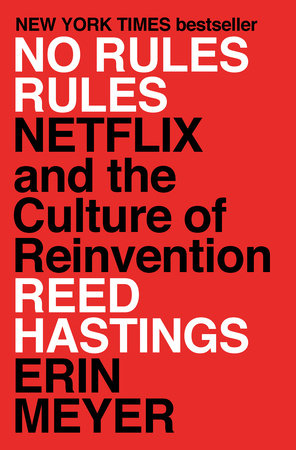No Rules Rules: Netflix and the Culture of Reinvention by Reed Hastings & Erin Meyer
(New York: Penguin, 2020), 320
See Netflix Jobs
See How Netflix Reinvented HR
First Steps to a Culture of Freedom and Responsibility
Chapter 1: First Build Up Talent Density
Summary: A great workplace is stunning colleagues
- Your #1 goal is to develop a work environment with only stunning colleagues
- Sunning colleagues accomplish significantly more than average ones
- Jerks, slackers, sweet people with nonstellar performance, or pessimists left on the team will bring down the performance of everyone
Chapter 2: Then Increase Candor
Summary: Say what you really think (with positive intent)
- With candor, high performers become outstanding performers. Frequent candid feedback magnifies the speed and effectiveness of your team.
- Build feedback into regular meetings
- Give feedback using the 4A guidelines:
- Assist: feedback must be given with positive intent
- Actionable: focus on what the recipient can do differently
- Appreciate: how can I show appreciation for this feedback rather than being defensive?
- Accept or Discard: the decision to react to the feedback is up to the recipient
- As the leader solicit frequent feedback and respond with belonging cues
- Get rid of jerks as you instill a culture of candor
Chapter 3: Now Begin Removing Controls
Summary: Remove vacation policy and travel and expense approvals
- Vacation policy
- Employees have full discretion on taking a few hours, a day, a week, or a month off work
- The leader must provide example of how the policy is implemented and be loud about the vacation she takes
- Travel policy
- Managers must set context on appropriate uses of company money
- Finance audits a percentage of expenses annually
- When people abuse the system, fire them and speak about the abuse openly
- With expense freedom employees will be able to make quick decisions to spend money in ways that helps the business
Next Steps to a Culture of Freedom and Responsibility
Chapter 4: Fortify Talent Density
Summary: Pay top of personal market
- Pay creative (vs operational) employees top of market (which may mean hiring one exceptional individual rather than ten adequate people)
- Don't pay performance-based bonuses, but put those resources into salary
- Take calls from recruiters to get to know your own and your team's market value
Chapter 5: Pump up Candor
Summary: Open the books
- Encourage transparency by getting rid of closed offices, locked spaces, etc.
- Share sensitive financial and strategic information with all employees
- Notify employees about possible changes early even if they cause anxiety and distraction
- If information is about something that happened at work, share it. If information is personal say it's not your place to share but refer to the person
- As long as you have already shown yourself to be competent talking openly about your own mistakes will increase trust an goodwill
Chapter 6: Release More Controls
Summary: No decision-making approvals needed
- Ownership of decisions should be dispersed across the team at all levels
- For this to work: "don't seek to please your boss"
- Think in bets: some will succeed and some will fail, and you are judged on the collective outcome rather than a single bet
- When a bet fails, sunshine it openly
Techniques to Reinforce a Culture of Freedom and Responsibility
Chapter 7: Max up Talent Density
Summary: The Keeper Test
- The Keeper Test: "Which of my people, if they told me they were leaving for a similar job at another company, would I fight hard to keep?"
- Avoid stack-ranking systems which create competition and discourage collaboration
- A sports team is a better metaphor than a family: keep the best player in each position
- When an employee is underperforming, take the money that would have gone into a PIP and instead put it toward a generous severance package
- To reduce fear among employees, encourage them to use the Keeper Test with their managers
- When an employee is let go, speak openly about what happened and answer questions
Chapter 8: Max up Candor
Summary: A circle of feedback
- A thorough session every 6-12 months ensures clear feedback
- Performance reviews are not the best mechanism for candid feedback since they only go one way and involve one person
- A 360 written report is a good mechanism for annual feedback but make sure it is not anonymous
- Live 360 dinners are effective for feedback in a Start, Stop, Continue format
Chapter 9: Eliminate Most Controls
Summary: Lead with context, not control
- Leading with context is best when you goal is innovation (not error prevention), and requires a loosely coupled system
- Instead of telling people what to do, get into alignment by providing and debating all the context that will allow them to make good decisions
- When someone on your team fails, ask yourself what context you forgot to set
- A loosely coupled organization should resemble a tree rather than a pyramid: the boss is at the roots, holding the trunk of senior mangers who supports the branches where decisions are made
Going Global
Chapter 10: Bring It to the World
Summary:
- Map your corporate culture and compare it to the cultures of the countries you are expanding to
- In less direct countries, implement more formal feedback mechanisms
- With more direct cultures, talk about the cultural difference openly so the feedback is understood as intended
- Add "adaptability" to your candor model
Topic: Management
Source:
Created: 2021-11-08
Updated: 2023-06-21-Wed
